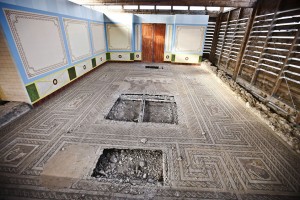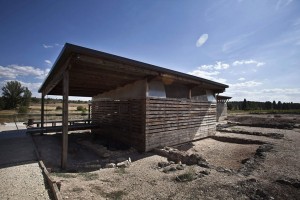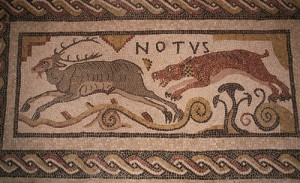 Thieves broke into an unguarded Roman villa in the tiny northern Spanish burg of Baños de Valdearados (population 419) and brutally hacked out three panels of a 5th century floor mosaic dedicated to the god Bacchus. Two Catalan tourists discovered the monstrous crime on Wednesday, December 28th when they arrived to visit the Roman villa of Santa Cruz and saw through the wooden slats that enclose the ruins that chunks of the mosaic floor were missing.
Thieves broke into an unguarded Roman villa in the tiny northern Spanish burg of Baños de Valdearados (population 419) and brutally hacked out three panels of a 5th century floor mosaic dedicated to the god Bacchus. Two Catalan tourists discovered the monstrous crime on Wednesday, December 28th when they arrived to visit the Roman villa of Santa Cruz and saw through the wooden slats that enclose the ruins that chunks of the mosaic floor were missing.
 There is no guard during the winter. The door is padlocked and when tourists come they call a number and someone ambles over to let them in and show them the remains. All the looters had to do to get in is break a couple of the wooden slats. The mosaic was intact when the previous tour was given December 23rd, so the thieves must have broken in some time during that week. Mayor Lorenzo Izcara thinks it went down the night of December 27th, just before the tourists discovered the theft.
There is no guard during the winter. The door is padlocked and when tourists come they call a number and someone ambles over to let them in and show them the remains. All the looters had to do to get in is break a couple of the wooden slats. The mosaic was intact when the previous tour was given December 23rd, so the thieves must have broken in some time during that week. Mayor Lorenzo Izcara thinks it went down the night of December 27th, just before the tourists discovered the theft.
 The loss is irreparable. The looters used a hammer and chisel to crudely bust out the three panels: a central figurative scene that depicts Bacchus in Triumph standing in his chariot being pulled by a pair of panthers, a hunting scene of a dog chasing a deer labeled “Notus,” the Greek name for the south wind, and another scene of a dog chasing a doe labeled “Boreas,” Greek for the north wind.
The loss is irreparable. The looters used a hammer and chisel to crudely bust out the three panels: a central figurative scene that depicts Bacchus in Triumph standing in his chariot being pulled by a pair of panthers, a hunting scene of a dog chasing a deer labeled “Notus,” the Greek name for the south wind, and another scene of a dog chasing a doe labeled “Boreas,” Greek for the north wind.
The entire mosaic takes up 66 square meters, and the mayor says that considering the enormous size of one of the stolen portions, the criminals must have cut it up in pieces “because it would not have fitted through the hole they made to get in.”
This is not the first time the site has been vandalized. In November, several individuals broke in and destroyed a few square centimeters of the mosaic, forcing authorities to change the locks and adopt a few additional security measures. “The restorer told me then that the mosaic would be very difficult to steal because it had reinforced concrete, but they’ve stolen it all right,” says the mayor, who had already warned the regional government of Castilla y León about the need to improve the site’s surveillance system.
A regional official will be visiting the site this month. Perhaps the immediate horror will get some much-needed investment in security for these off-the-beaten-track gems, but the overall problem remains a knot of Gordian dimensions: 23,000 archaeological sites to protect in the region, no money and personnel to protect them.
It was one of the best preserved Roman mosaics in the country, rare for its immense size (710 square feet), its excellent condition and for the rare combination of Bacchic scenes depicting both the god’s betrothal to Ariadne and his Triumph. Only two other known mosaics depict both those scenes.
The stolen pieces will be almost impossible to sell openly because of how recognizable they are. The police and mayor think the theft was commissioned by an unscrupulous private collector/rapist. I don’t know how likely that is. Art thefts often get chalked up to shady commissions, then you find the Picassos in the trunk of a car years later because the thieves were unable to sell their ill-gotten gain. Also, I don’t really see this artsy Blofeld being thrilled when his minions hand over hacked out chunks of mosaic. If someone is commissioning thefts of antiquities, they probably require their stuff be handled with care or else it’s into the pool with the sharks with frickin’ laser beams attached to their frickin’ heads.
The Roman villa of Santa Cruz was unearthed in November of 1972 during farm work. Excavations ended after a few years with only an estimated fourth of the site uncovered, including the Bacchic mosaic. The digs revealed an elaborate villa with at least 10 rooms, including baths heated by a hypocaust system, and four halls. The home is typical of late Imperial period (between the fourth and sixth centuries) latifundia, great agricultural estates manned by vast numbers of slaves and owned by absentee landlords.
Liv, you have your finger more firmly on the pulse of such news stories than I do. I often hear of art piracy of this kind in Italy–at museums, archeological sites, churches, villas… But I live in Italy, so I would hear things! You describe a particularly heinous case, but are such horrors relatively rare in Spain? It took time to hack out the three mosaic panels (however crudely), which might mean that the perpetrators knew that the (alleged) guard was paying a Christmas visit to his aunt in the next village. I suspect that there is a crew of half-assed (but fully destructive) locals who were obsessing over these mosaics ever since 1972. Now, they sitting around someone’s garage staring at three heaps of semi-rubble, wondering what to do next.
I haven’t seen any such mutilations in the Spanish press, but I’m sure there is a lot of local news that never reaches me. With so many scattered and remote ancient sites, I’d be amazed if this was the only instance of a hacking job. I think your suspicion about a hapless local operation is a solid one. I really don’t see this as the work of a big city crew.
I don’t know which is more disgusting, the theft or the total disregard for the safety of the mosaics shown by the authorities. I am not surprised this happened in Spain.